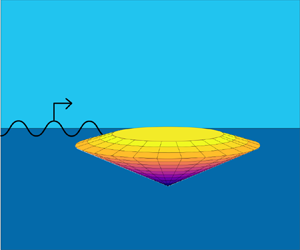Article contents
Optimisation of the geometry of axisymmetric point-absorber wave energy converters
Published online by Cambridge University Press: 17 December 2021
Abstract

We propose a scientifically rigorous framework to find realistic optimal geometries of wave energy converters (WECs). For specificity, we assume WECs to be axisymmetric point absorbers in a monochromatic unidirectional incident wave, all within the context of linearised potential theory. We consider separately the problem of a WEC moving and extracting wave energy in heave only and then the more general case of motion and extraction in combined heave, surge and pitch. We describe the axisymmetric geometries using polynomial basis functions, allowing for discontinuities in slope. Our framework involves ensuring maximum power, specifying practical motion constraints and then minimising surface area (as a proxy for cost). The framework is robust and well-posed, and the optimisation produces feasible WEC geometries. Using the proposed framework, we develop a systematic computational and theoretical approach, and we obtain results and insights for the optimal WEC geometries. The optimisation process is sped up significantly by a new theoretical result to obtain roots of the heave resonance equation. For both the heave-only, and the heave-surge-pitch combined problems, we find that geometries which protrude outward below the waterline are generally optimal. These optimal geometries have up to 73 % less surface area and 90 % less volume than the optimal cylinders which extract the same power.
JFM classification
- Type
- JFM Papers
- Information
- Copyright
- © The Author(s), 2021. Published by Cambridge University Press
References
REFERENCES
- 9
- Cited by





